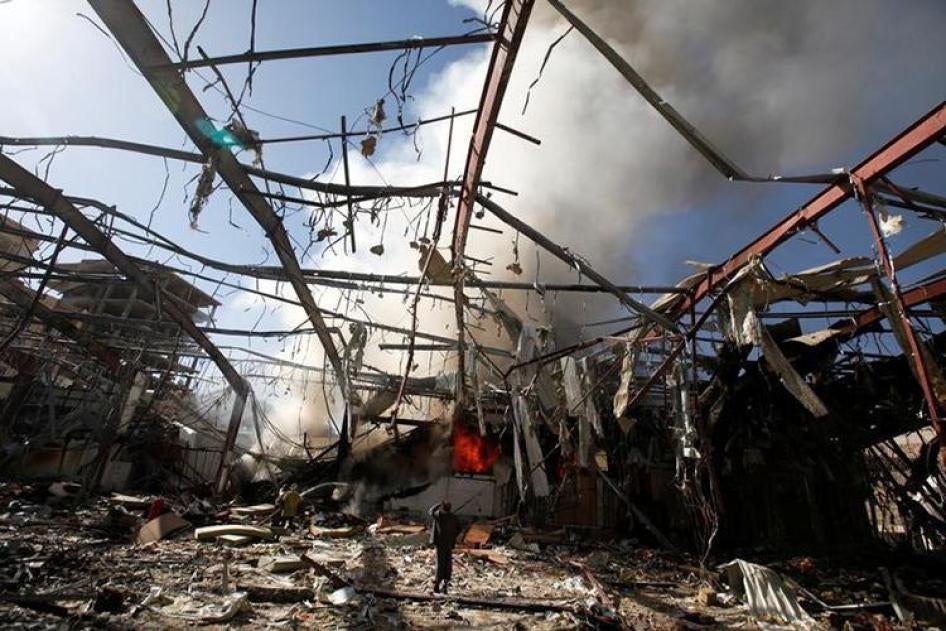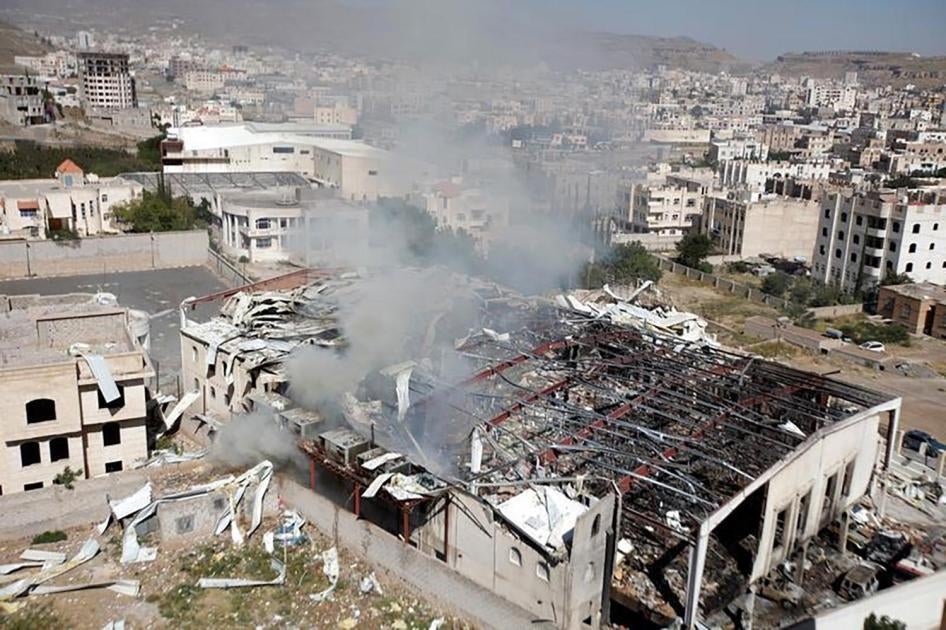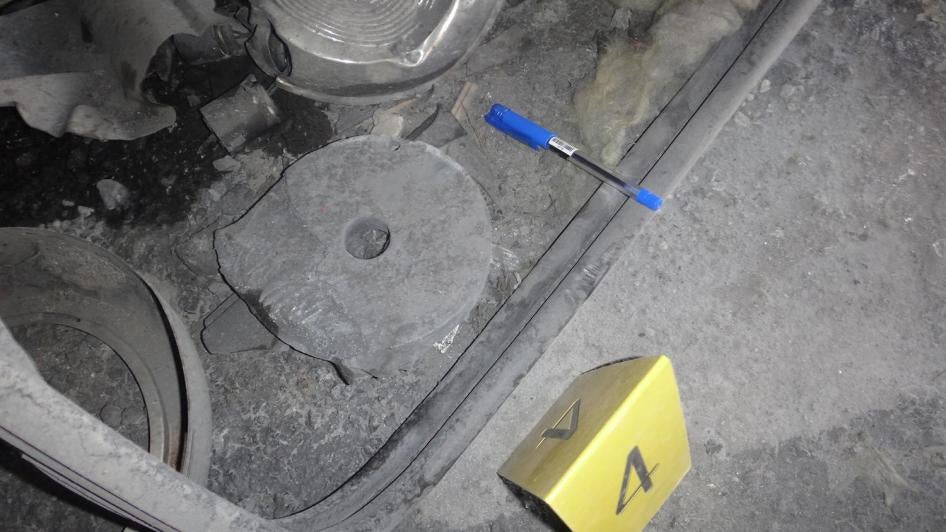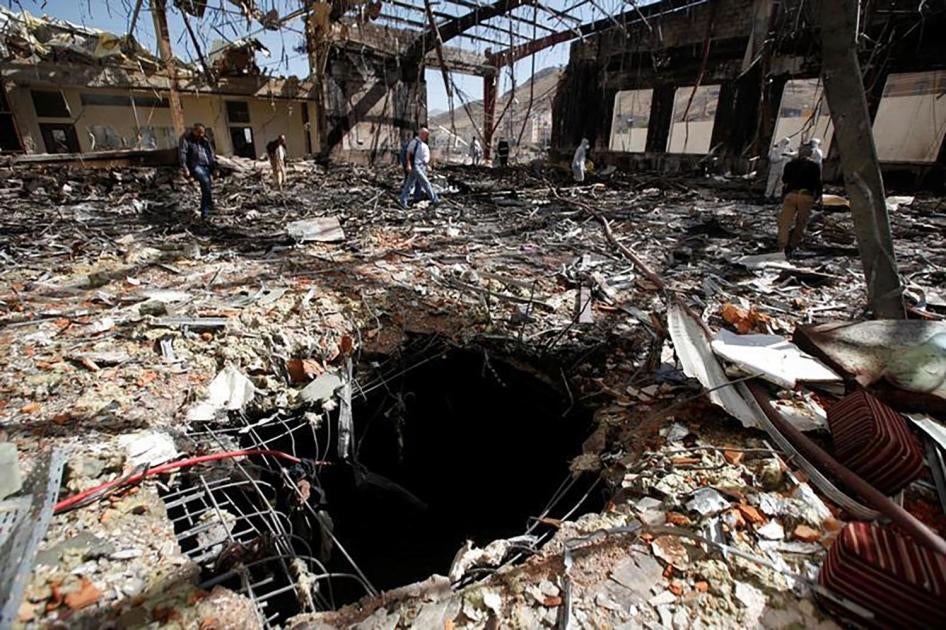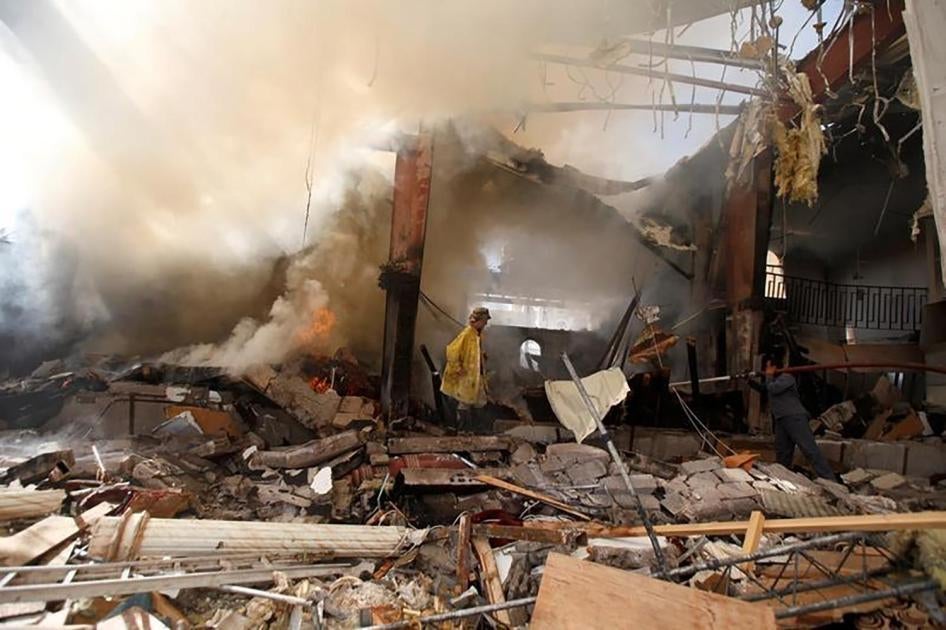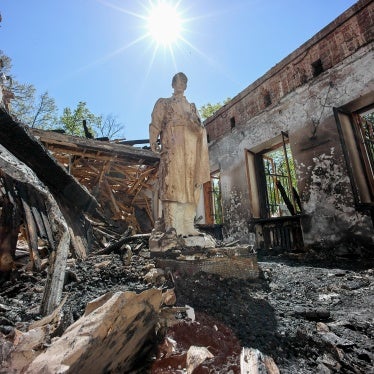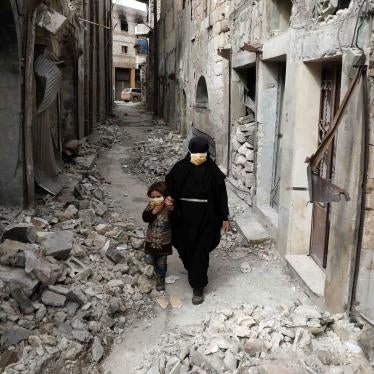(Beirut) – A Saudi Arabia-led coalition airstrike on a crowded funeral ceremony in Yemen’s capital, Sanaa, on October 8, 2016, is an apparent war crime. The attack killed at least 100 people and wounded more than 500, including children. While military personnel and civilian officials involved in the war effort were attending the ceremony, the clear presence of several hundred civilians strongly suggests that the attack was unlawfully disproportionate.
The funeral strike underscores the urgent need for credible international investigations into alleged laws-of-war violations in Yemen, Human Rights Watch said. The United States, United Kingdom, and other governments should immediately suspend arms sales to Saudi Arabia. The coalition should urgently allow commercial flights to Sanaa, suspended in August, to allow anyone who is sick or wounded to seek medical treatment abroad.
“After unlawfully attacking schools, markets, hospitals, weddings, and homes over the last 19 months, the Saudi-led coalition has now added a funeral to its ever-increasing list of abuses,” said Sarah Leah Whitson, Middle East and North Africa director. “An independent international investigation of this atrocity is needed as the coalition has shown its unwillingness to uphold its legal obligations to credibly investigate.”
Human Rights Watch interviewed 14 witnesses to the attack and two men who arrived at the scene immediately after the airstrike to help with rescue efforts, among other sources, by phone, and reviewed video and photos of the strike site and weapons remnants.
On October 8, several hundred people had gathered in the al-Sala al-Kubra community hall, which has a capacity of over 1,000, for the funeral ceremony of Ali al-Rawishan, the father of the Sanaa-based administration’s interior minister, Jalal al-Rawishan. All the witnesses who spoke to Human Rights Watch said that at about 3:30 p.m., at least two air-dropped munitions penetrated the roof of the hall and detonated a few minutes apart.
Photos and video footage taken after the attack show charred and mutilated bodies strewn in and outside the hall, the building destroyed, and rescuers carrying out bodies to ambulances. A spokesman for the Sanaa-based Health Ministry, Dr. Tamim al-Shami, told Human Rights Watch on October 9 that at least 110 people had been killed and 610 wounded, but that the death toll was likely to rise because a number of bodies had been burned or mutilated beyond recognition. Human Rights Watch was unable to independently verify the ministry’s figures, but soon after the attack, Doctors Without Borders reported that six of its hospitals had treated over 400 wounded.
One witness said, “When I got there, there were more than 50 burned bodies, many where you can still tell the features, but half of their body was gone, half of their head was gone, but the others, it was very, very hard to tell who they were.”
Hundreds of those killed and wounded were civilians, according to the United Nations Office of the High Commissioner for Human Rights (OHCHR). One witness said that he personally knew at least 45 civilians who had been killed in the attack. At least 20 high-ranking officials affiliated with former president Ali Abdullah Saleh’s General People’s Congress and the Houthis, also known as Ansar Allah, as well as military and security officials, were at the funeral, and several were among the casualties. The Saudi Arabia-led coalition began an aerial campaign against the Houthis and allied forces in March 2015.
Under the laws of war, an attack is unlawfully disproportionate if it may be expected to cause incidental loss of civilian life or damage to civilian structures that would be excessive in relation to the concrete and direct military advantage anticipated from the attack. Only military personnel and civilian officials involved in military operations against the coalition would be considered legitimate targets.
Serious violations of the laws of war committed willfully – that is, intentionally or recklessly – are war crimes. The date and place of the funeral ceremony was announced on Jalal al-Rawishan’s Facebook page on October 7, and would have been publicly available. The afternoon hour of the attack would have been known to be the “peak time” when the funeral ceremony, open to the public, would have been very crowded. Coalition forces should have known that while a number of high-ranking commanders would be gathered, any attack on the hall would result in massive civilian casualties.
Human Rights Watch identified the munition used as a US-manufactured air-dropped GBU-12 Paveway II 500-pound laser-guided bomb. The identification was based on a review of photos and footage of an intact guidance fin assembly with legible manufacturer’s markings and other weapon remnants. The photos and video were taken at the scene of the attack by Mwatana, a leading Sanaa-based human rights organization, journalists from the British news channel ITV, and a local activist, who visited the site on October 9.
Coalition sources initially denied responsibility for the attack, but the following day the coalition announced it would investigate the incident with support from the US. The BBC reported the UK also requested to be involved in the investigation. However, the coalition has not conducted previous investigations impartially or transparently, nor publicly carried out prosecutions for alleged war crimes, or provided redress for victims.
On October 12, Saudi Arabia’s King Salman directed the King Salman Center for Relief and Humanitarian Aid to coordinate with the coalition, the government of Yemen, and the UN to facilitate the transfer of victims of the October 8 airstrike out of Yemen to access medical treatment abroad. The royal decree did not lift the overall ban on commercial flights into Sanaa, suspended since August.
Since March 26, 2015, the Saudi-led coalition of nine Arab countries, with direct military support from the US and assistance from the UK, has conducted numerous unlawful attacks in Yemen. Human Rights Watch has documented 58 unlawful airstrikes causing civilian loss of life and property. Other human rights organizations, as well as the UN, have documented dozens more. The Houthis and their allies, including forces loyal to former president Saleh, have also committed numerous serious abuses.
Between March 2015 and October 2016, 4,125 civilians had been killed and 7,207 wounded in Yemen, according to OHCHR, the majority by coalition airstrikes. OHCHR reported in August that airstrikes had been the “single largest cause of casualties” over the past year.
Saudi Arabia, which is currently running unopposed for re-election to the Human Rights Council and has previously used its position to obstruct efforts to establish an international inquiry into ongoing violations in Yemen, has no place on the UN body, Human Rights Watch said.
The independent investigative role of the OHCHR is crucial, and its findings on the funeral strike and other serious violations of international law by all parties to the conflict in Yemen should be presented to the Human Rights Council at the earliest opportunity. The US, as a party to the conflict, is legally responsible for the role of its forces in any unlawful attack, and should credibly investigate alleged violations and take appropriate disciplinary or criminal action.
The US, UK, and other governments should immediately suspend arms sales to Saudi Arabia until it curbs unlawful attacks and credibly investigates those that have already occurred, Human Rights Watch said.
“The US, UK, and other coalition allies should send an unequivocal message to Saudi Arabia that they want no part in these crimes,” Whitson said. “Yemeni civilians should not be asked to tolerate such madness a moment longer.”
Funeral Strike
The funeral ceremony at al-Sala al-Kubra for Ali al-Rawishan, a public figure and the father of the Sanaa-based administration’s interior minister, was attended by several hundred people, including colleagues, friends, and relatives of the deceased. Funeral ceremonies of public figures in Yemen are customarily well-attended and open to all male members of the public.
I couldn’t see anyone. … There was a lot of dust and smoke and screaming. We started running away as many others did. The back gate was closed but we broke it. We were 20 meters away from the great hall when suddenly another strike happened. I heard the sound of a plane.
Al-Baredah said he heard two more munitions detonate in the hall a few minutes apart before fleeing the area.
Abdulla al-Shami, 35, a businessman whose leg was injured in the strike, said:
I was inside sitting at the funeral when the airstrike happened… I couldn’t see who was next to me, I was looking for an exit. There were dead bodies and body parts, some people under rubble… There were children inside before the strike, but I couldn’t see anyone after the strike. It was dark. I just saw the light and ran toward it to escape.
The second munition affected people trying to enter the building to help survivors after the first bomb detonated. “Ahmed” (pseudonym), a businessman in his thirties who asked not to be identified, went to the hall shortly before 4:00 p.m. to help with the rescue effort after several of his friends who had been at the funeral called him asking him for help. He said that his cousin, who was near the hall when the first munition detonated, tried to rush in to help survivors. His cousin was thrown backward off his feet when the second munition exploded.
“Ahmed” told Human Rights Watch:
The scene was catastrophic. Beyond what I can explain to you or describe… There were burned bodies and dead bodies all over the hall... When I got there, there were more than 50 burned bodies, many where you can still tell the features, but half of their body was gone, half of their head was gone, but the others, it was very, very hard to tell who they were.
“Ahmed” said he helped carry bodies out from under the debris and place them in body bags, while others on the scene tried to put out the fire raging in the hall. He saw at least seven children who had been in the hall, some of whose family members had died. He said 15 of his friends or family members, all civilians, had been killed in the strike, and at least six wounded.
Accountability
The coalition announced in a statement carried by the official Saudi news agency that its Joint Incidents Assessment Team (JIAT) would investigate the funeral strike with US support. JIAT has not met international standards for transparency, credibility, and impartiality, and the Saudi-led coalition should not only investigate but cooperate with UN investigations into the incident.
The high commissioner for human rights, Zeid Ra’ad al-Hussein, denounced the funeral attack as “outrageous” and repeated his call for an independent international inquiry into alleged violations of international human rights and humanitarian law in Yemen. The OHCHR should undertake an immediate investigation into the incident and promptly brief the UN Human Rights Council on its findings.
Despite mounting violations of international human rights and humanitarian law by all sides in the conflict in Yemen, no participating government has conducted credible investigations into alleged war crimes, as international law requires.
In September 2016, the Human Rights Council passed a resolution laying out two complementary processes for investigations, through the OHCHR itself, strengthened by the allocation of additional human rights experts, or through the Coalition-backed Yemeni National Commission set up by Presidential Decree No. 13 (2015).
In the course of its work, the Yemeni commission, which reports to President Abdrabbuh Mansour Hadi and does not have access to many parts of the country, has not complied with international standards of impartiality, independence, and effectiveness, Human Rights Watch said. Its first report focused almost entirely on Houthi and allied forces violations. The funeral strike will be a test of the commission’s credibility, Human Rights Watch said, but the UN should conduct its own independent investigation and report its findings to the Human Rights Council at the earliest opportunity to ensure that all those responsible are held to account.
US Role
The US became a party to the conflict during the first months of fighting by providing specific targeting information and refueling planes during bombing raids, Human Rights Watch said. Reuters recently reported that US officials debated internally whether US support to the Saudi-led coalition made the US a co-belligerent, and were concerned that US officials could be criminally liable for war crimes committed in Yemen.
Immediately following the funeral strike, US National Security Council spokesperson Ned Price said the US was “deeply disturbed” by the incident, “which, if confirmed, would continue the troubling series of attacks striking Yemeni civilians.” Price announced the US had “initiated an immediate review of our already significantly reduced support” to the coalition and was “prepared to adjust our support.”
A thorough review of US support to the coalition is a step forward, but does not absolve the US of potential liability for any coalition military operations in which US forces participated that resulted in war crimes, Human Rights Watch said. The review of the funeral attack should be thorough and transparent, but the US should also examine the role of its forces in other alleged unlawful attacks in Yemen. The US Congress should exercise more effective oversight over US involvement in the Yemen conflict, for instance by holding investigatory hearings during the next Congress, Human Rights Watch said.
Human Rights Watch has repeatedly documented coalition use of US and UK-produced weapons, including cluster munitions, in unlawful attacks in Yemen. The US continues to sell arms to Saudi Arabia, approving more than US$20 billion in military sales in 2015 alone, despite increasing recognition that the coalition may use these weapons unlawfully. Three US arms sales in 2015 and 2016, worth nearly $3 billion, involved replenishing Saudi weaponry used in Yemen.
The UK government also continues to sell arms to Saudi Arabia, despite growing parliamentary pressure over its support for Saudi Arabia’s military campaign in Yemen and evidence of the use of British-made weapons in Yemen. Since March 2015, the UK has approved £2.8 billion in military sales to Saudi Arabia, according to the London-based Campaign Against Arms Trade.
